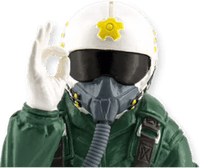The Stall
by Todd Breda(Actual author is Martin Bedding)
It’s been my experience over the years one of the least understood things about flight and in particular with R/C models is the stall. What is it, why does it happen and when does it happen and more importantly how can we prevent it from happening.
A stall occurs when the weight of the aircraft can no longer be supported by the lift being generated by the wing ( helicopter beats the air into submission) and this can and will occur in many attitudes and not just at reduced power in straight and level flight. One of the most important things to bear in mind with a model is the weight. The lighter the model the better it will perform in flight and the lower the stall speed will be. This is relevant for all models both large and small. It’s a false assumption the stronger the model the more likely it is to survive a crash this is not the case. It doesn’t matter how much strength you built into a model it will always break at the weakest point in the event of a crash. A model is only as strong as the weakest part.
Let's take two models of the same design and size one weighs 6lbs and the other weigh 7lbs. The lighter model will have a lower stalling speed than the heavier one because the heavier model will have to fly at a higher airspeed to generate the same lift required to keep it in the air. The light model will have a lower stall speed which means it will also be able to land at a lower speed this will reduce the risk of damage in a hard landing. A slower speed on landing will also give you the pilot more time to think ahead of what you need to do to keep the wings level and the model pointing down the runway.
In straight and level flight lets assume the stall speed of a given model to be 25MPH this would be the ideal airspeed for the model to stall and flare to land on the runway. The same aircraft in a bank with the wings at say 30º the stalling speed goes up to about 30MPH. In a bank of 45º the stalling speed increases to around 45MPH. Now increase the angle of bank to 60º and the stalling speed could be 50 to 55MPH. The stalling speed increase dramatically with the angle of bank and if you incorporate elevator as well to initiate a turn the airspeed now starts to reduce because of the induced drag. If the pilot is not aware the model will rapidly loose height and crash if measures are not taken to rectify the situation. The above situation is even more relevant with an EDF because there is reduced airflow over the flying surfaces. With a propeller driven model there is airflow over the control surfaces from the propeller. However, please note the airflow will only be over the elevator and rudder. The ailerons will have little or no authority out towards the tip of the wing.
Now, consider a landing circuit the model is on the downwind leg of the pattern, you have reduced power and loosing height. At a given point you make a 90º turn onto a base leg all the while reducing the power slightly to reduce the height. The last turn on to the final for the approach is the most likely place the model will stall and crash if the pilot is unaware. As you make the turn you roll the aircraft into a bank and at the same time you start to apply up elevator and perhaps the rudder as well. These are the same control inputs for a spin. The final turn onto the landing approach should always be a very shallow gentle turn.
The model is nicely lined up on the final; approach to landing everything looks good when suddenly WHAM, BANG the model drops a wing and crashes. What happened, you have just experienced a tip stall. So what creates a tip stall and how can we prevent it I hear you say. A tip stall occurs when the lift at the wing tip stops generating lift and the root or center of the wing continues to do so. In other words more lift is generated at the center of the wing that at the tip and because of this the tip will drop Hence the name “Tip Stall”.
It happens mainly with a tapered wing and, again the weight of the model plays an important part it should be light. After the model has been built and finished there is very little you can do. However, there is one little trick that works and that is to raise both ailerons up slightly above the trailing edge of the wing somewhere between 1/32” and 1/16”. This has the effect of creating lift at the tip it’s called “Wash Out”. Anything more than this needs to be addressed in the design and building stages. Please note this only works with the model the right way up in flight. Inverted it has the opposite effect and it’s called “Wash In”. If you only intend to fly the model the right way up or inverted at no lower than half throttle inverted it will be fine.
Aerobatic aircraft have tip stalling capabilities built into the design, they need to be able to snap roll and spin cleanly and predictably.
The power stall is the last one I want to mention. Your model accelerates down the runway to takeoff and lifts off into the air and starts a nice shallow climb at which point you increase the angle and rate of climb. The model starts to slow down while still on full power and is nor rapidly loosing airspeed. More up elevator will only make the situation worse. If you don’t take immediate action the model will stall and likely crash. The only course of events to prevent a crash is to push the nose down to increase the airspeed.
In a stall situation you have to increase the airspeed so the wing can generate sufficient lift for the model to fly. You may have to level the wings first it will depend on the attitude the model is in.
Finally I hope this helps you prevent a crash and it may also help when you have an unexplained crash.

Hobby Squawk Community Forum
visit forum
RC Knowledge Blog
visit blog
Guidance & advice for beginners
Find out more- Choosing a selection results in a full page refresh.
- Press the space key then arrow keys to make a selection.
